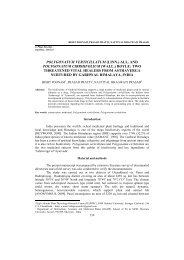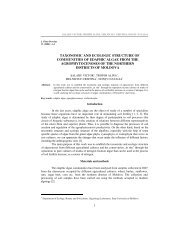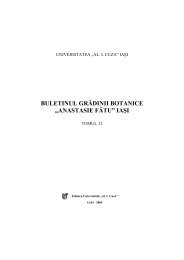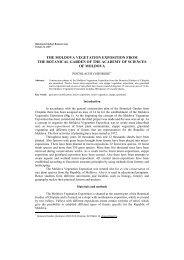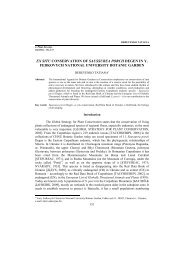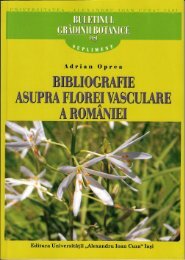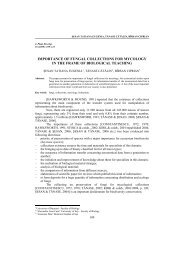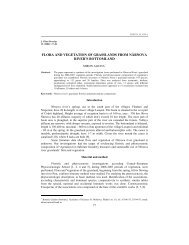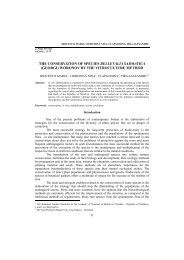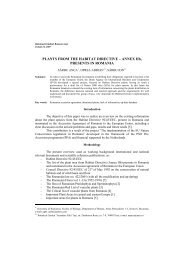contributions to the vegetation study from the vaslui river basin
contributions to the vegetation study from the vaslui river basin
contributions to the vegetation study from the vaslui river basin
You also want an ePaper? Increase the reach of your titles
YUMPU automatically turns print PDFs into web optimized ePapers that Google loves.
IRIMIA IRINA<br />
J. Plant Develop.<br />
15 (2008): 99–104<br />
CONTRIBUTIONS TO THE VEGETATION STUDY FROM THE<br />
VASLUI RIVER BASIN (I)<br />
IRIMIA IRINA ∗<br />
Summary:<br />
This paper presents two associations <strong>from</strong> <strong>the</strong> Rhamno - Prunetea Rivas Goday et Borja Carbonell<br />
1961 class and <strong>the</strong> Salicetea purpureae Moor 1958 class.<br />
Key words: phy<strong>to</strong>coenology, bioforms, floristic elements, ecological indices.<br />
Introduction<br />
The Vaslui River Basin is located in <strong>the</strong> central area of <strong>the</strong> Moldavian Plateau,<br />
between Iai in <strong>the</strong> North and Vaslui in <strong>the</strong> South. The terri<strong>to</strong>ry being characterized by a<br />
hilly relief of a plateau, interrupted by several valleys. It is characterised by a temperate<br />
continental climate, with dry and cold winters and hot or even very hot and dry summers.<br />
The prevailing soils here are chernozems, on <strong>the</strong> plateaus and slopes, and alluvial soils,<br />
along <strong>the</strong> meadows and narrow valleys.<br />
Material and methods<br />
For <strong>the</strong> identification of plant associations, we used phy<strong>to</strong>sociological research<br />
methods according <strong>to</strong> <strong>the</strong> Central–European school. The establishment of <strong>the</strong> bioforms and<br />
floristic elements was made on <strong>the</strong> basis of Flora ilustrat a României – Pteridophyta et<br />
Sperma<strong>to</strong>phyta, by V. Ciocârlan (2000) [2]. The ecological indices were noted having in<br />
mind <strong>the</strong> works of H. Ellenberg [4].<br />
After analysing some recent papers on phy<strong>to</strong>sociological nomenclature and<br />
classification [1, 5, 8], <strong>the</strong> associations presented in this work have been included in <strong>the</strong><br />
following phy<strong>to</strong>coeno-system:<br />
RHAMNO – PRUNETEA Rivas Goday et Borja Carbonell 1961<br />
PRUNETALIA SPINOSAE R. Tx. 1952<br />
PRUNION SPINOSAE Soó 1951<br />
Pruno spinosae – Crataegetum Hueck 1931<br />
SALICETEA PURPUREAE Moor 1958<br />
SALICETALIA PURPUREAE Moor 1958<br />
SALICION ALBAE Soó 1930<br />
Salicetum albae Issler 1926<br />
∗<br />
“Alexandru Ioan Cuza” University, Faculty of Biology. B-dul Carol I, 20 A, Iai, Romania,<br />
iblaj2002@yahoo.com<br />
99
CONTRIBUTIONS TO THE VEGETATION STUDY FROM THE VASLUI RIVER BASIN (I)<br />
Results and discutions<br />
Ass. Pruno spinosae – Crataegetum Hueck 1931<br />
(Syn.: Pruno spinosae – Crataegetum Soó 1931)<br />
Chorology: Chirceti (Mititelu D., 1975), Emil Racovi, Dneti, Poieni, Pripoare<br />
hill, Dobrov<br />
Ecology: The Prunus spinosa and Crataegus monogyna bushes are encountered at<br />
<strong>the</strong> edge of woods and glades, on cleared sites or sunny coasts.<br />
The phy<strong>to</strong>coenological characterisation: Besides <strong>the</strong>se two edifying species we<br />
also encounter: Rosa canina, Rubus caesius, but also a large number of herbaceous species<br />
in <strong>the</strong> classes Festuco-Brometea conferring <strong>the</strong> association a xerophile character,<br />
alternating with <strong>the</strong> mesophile character, Molinio-Arrhena<strong>the</strong>retea. The species<br />
characteristic <strong>to</strong> <strong>the</strong> classes Artemisietea vulgaris and Stellarietea mediae show <strong>the</strong> effect of<br />
<strong>the</strong> anthropozoogenous actions (Tab. 1).<br />
After <strong>the</strong> analysis of <strong>the</strong> surveys we noticed <strong>the</strong> following: <strong>the</strong> bioforms spectrum<br />
shows us <strong>the</strong> dominance of hemicryp<strong>to</strong>phytes (73.22%), followed by terophytes (7.14%)<br />
and hemiterophytes (10.71%) which underlines <strong>the</strong> presence of <strong>the</strong> anthropic fac<strong>to</strong>r in <strong>the</strong><br />
area. The presence of <strong>the</strong> phanerophytes amounts <strong>to</strong> a percentage of 8.93%. The<br />
phy<strong>to</strong>geographical spectrum indicates <strong>the</strong> dominance of <strong>the</strong> Eurasian elements (64.27%),<br />
followed by European (19.64%) and Pontic (8.94%), reflecting thus <strong>the</strong> temperate character<br />
of <strong>the</strong> area and also <strong>the</strong> presence of <strong>the</strong> species <strong>from</strong> <strong>the</strong> Sou<strong>the</strong>rn area. Besides<br />
circumpolar elements (3.57%), cosmopolite (1.79%) and adventive (1.79%) participate.<br />
The spectrum of ecological indices indicate <strong>the</strong> presence of heliophilous species (45.65%),<br />
amphi<strong>to</strong>lerant <strong>to</strong> temperature (39.14%) with spreading area in Central Europe (39.13%)<br />
which develop on dry up <strong>to</strong> moderate-humid soils (39.13%), amphi<strong>to</strong>lerant with regard <strong>to</strong><br />
soil reaction (50%) and <strong>the</strong> amount of mineral nitrogen in <strong>the</strong> soil (19.56%).<br />
Observations: The association has been recorded in this area within a <strong>study</strong>, but<br />
without presenting a table of floristic surveys.<br />
Table 1. Ass. Pruno spinosae – Crataegetum Hueck 1931<br />
Number of survey 1 2 3 4 5 6<br />
Altitude (m.s.m.) 320 328 245 310 245 270<br />
Exposition - NV - E - S<br />
Slope (º) - 2 - 8-9 - 20<br />
Coverage of <strong>the</strong> shrub layer (%) 90 70 65 50 85 60<br />
Coverage of <strong>the</strong> herbaceous layer (%) 20 6 5 10 15 5<br />
Surface of survey (m²) 50 25 25 25 50 50<br />
Number of species 30 14 13 14 24 38 K<br />
Association’s characteristics<br />
Prunus spinosa + 4 3 1 4 2 V<br />
Prunion spinosae et Prunetalia<br />
Crataegus monogyna 5 1 2 3 2 3 V<br />
Rubus caesius - + - - - - I<br />
Origanum vulgare - - - - + - I<br />
Rhamno-Prunetea<br />
Evonymus europaeus + - + + - + IV<br />
100
IRIMIA IRINA<br />
Rosa canina - + + - 1 + IV<br />
Clematis vitalba + - - + + - III<br />
Cornus sanguinea - + + - - + III<br />
Acer campestre - - - - - + I<br />
Querco-Fagetea<br />
Salvia glutinosa - - - - + - I<br />
Campanula rapunculoides - - - - - + I<br />
Carpinus betulus - - - - - + I<br />
Geum urbanum - - - - - + I<br />
Dryopteris filix-mas - - - - - + I<br />
Festuco-Brometea<br />
Achillea setacea + - - + - + III<br />
Fragaria viridis + - - - + + III<br />
Koeleria macrantha + - - - + - II<br />
Euphorbia glareosa ssp. glareosa + - - - + - II<br />
Eryngium campestre + - - + - - II<br />
Dichanthium ischaemum + - - - + - II<br />
Galium verum + - - - - + II<br />
Galium humifusum + - - - - - I<br />
Potentilla argentea + - - - - - I<br />
Echium vulgare + - - - - - I<br />
Salvia nemorosa + - - - - - I<br />
Inula germanica - - + - - - I<br />
Polygala major - - + - - - I<br />
Dianthus membranaceus - - - + - - I<br />
Hieracium bauhinii - - - - - + I<br />
Stachys germanica - - - - - + I<br />
Cerin<strong>the</strong> minor - - - - - + I<br />
Medicago falcata - - - - - + I<br />
Potentilla recta - - - - - + I<br />
Plantago media - - - - - + I<br />
Molinio-Arrhena<strong>the</strong>retea<br />
Trifolium repens + - - + + + IV<br />
Plantago lanceolata + + - - + + IV<br />
Cichorium intybus + - + + - - III<br />
Lotus corniculatus 1 - - + - + III<br />
Trifolium pratense + - - - + + III<br />
Centaurea jacea + + - - + - III<br />
Lolium perenne + + - - + - III<br />
Veronica chamaedrys - + - - + + III<br />
Achillea millefolium - + + - + - III<br />
Taraxacum officinale + - - + - - II<br />
Leucan<strong>the</strong>mum vulgare - + - - + - II<br />
Dactylis glomerata - - + - - + II<br />
Ranunculus acris - - - + - + II<br />
Medicago lupulina + - - - - - I<br />
Leon<strong>to</strong>don autumnalis + - - - - - I<br />
Stachys officinalis - - + - - - I<br />
101
CONTRIBUTIONS TO THE VEGETATION STUDY FROM THE VASLUI RIVER BASIN (I)<br />
Daucus carota - - - + - - I<br />
Rumex crispus - - - - - + I<br />
Ajuga reptans - - - - - + I<br />
Poa pratensis - - - - - + I<br />
Equisetum arvense - - - - - + I<br />
Artemisietea vulgaris<br />
Verbascum phlomoides + + - + - - III<br />
Echinops sphaerocephalus + - - - - - I<br />
Carduus nutans + - - - - - I<br />
Artemisia absinthium + - - - - - I<br />
Linaria vulgaris - + - - - - I<br />
Sambucus ebulus - - - + - - I<br />
Erigeron acris ssp. acris - - - - + - I<br />
Carduus acanthoides - - - - + - I<br />
Ballota nigra ssp. nigra - - - - + - I<br />
Berteroa incana - - - - - + I<br />
Elymus repens - - - - - + I<br />
Stellarietea mediae<br />
Erigeron annuus - + - - - + II<br />
Artemisia annua - - - + - + II<br />
Lathyrus tuberosus - - + - - - I<br />
Conyza canadensis - - + - - - I<br />
Torilis arvensis - - - - - + I<br />
Variae syntaxa<br />
Agrimonia eupa<strong>to</strong>ria + - - - + + III<br />
Galium album + - - - + - II<br />
Hypericum perforatum - - + - + - II<br />
Torilis japonica - + - - - - I<br />
Tanacetum corymbosum - - + - - - I<br />
Silene vulgaris - - - - + - I<br />
Dianthus armeria - - - - - + I<br />
Galium mollugo - - - - - + I<br />
Place and date of <strong>the</strong> surveys: 1. Emil Racovi, 6.08.2003; 2. Dneti,<br />
5.08.2002; 3, 5. Poieni, 27.07.2003, 06.2001; 4. Pripoare hill, 06.2001; 6.<br />
Dobrov, 1.07.2004<br />
Ass. Salicetum albae Issler 1926<br />
(Syn.: Salicetum albae-fragilis R. Tx. 1937)<br />
Chorology: Bârnova (Mititelu D. and collab., 1995), Dobrov, Pocreaca, Dneti,<br />
Codeti<br />
Ecology: The association was encountered in few places in <strong>the</strong> Vaslui River Basin<br />
and it occupies <strong>the</strong> major <strong>river</strong> bed and <strong>the</strong> brooks and <strong>river</strong>sides. It also shows in <strong>the</strong> form<br />
of narrow band accompanying <strong>the</strong> water courses and it rarely form dense <strong>river</strong>side<br />
coppices.<br />
The phy<strong>to</strong>coenological characterisation: The arborescent layer ensures a<br />
reduced covering and it is dominated by Salix alba, besides which Salix fragilis and<br />
102
IRIMIA IRINA<br />
Populus alba develop (Tab. 2). The bushes layer is poorly represented, we remind here<br />
Rubus caesius. With regard <strong>to</strong> <strong>the</strong> herbaceous layer, this is made of various hygrophilous<br />
species which withstand <strong>the</strong> floods or water stagnation for a long period of time, among<br />
which we mention: Urtica dioica, Phragmites australis, Glechoma hederacea, Bidens<br />
tripartita, Lythrum salicaria, Lycopus europaeus etc.<br />
After <strong>the</strong> analysis of <strong>the</strong> surveys we noticed <strong>the</strong> following: <strong>from</strong> <strong>the</strong> bioforms<br />
spectrum, <strong>the</strong> hemicryp<strong>to</strong>phytes (51.72%) dominate, followed by geophytes (13.78%),<br />
phanerophytes (17.25%), terophytes (10.35 %), hemiterophytes (3.45%) and hydrophytes<br />
(3.45%); <strong>from</strong> <strong>the</strong> phy<strong>to</strong>geographical spectrum, we observe dominance of <strong>the</strong> Eurasian<br />
elements (51.72%), followed by <strong>the</strong> cosmopolite (20.68%) and circumpolar (13.80%).<br />
Besides, <strong>the</strong> European elements (6.90%) also participate, <strong>the</strong> Central European (3.45%) and<br />
<strong>the</strong> adeventive (3.45%). The spectrum of ecological indices shows us <strong>the</strong> presence of <strong>the</strong><br />
species developing in full light (50%), meso<strong>the</strong>rmal (42.86%), with spreading area in<br />
Central Europe (35.71%), growing on damp-moist up <strong>to</strong> wet soils (8-25%, 10-17.85%),<br />
amphi<strong>to</strong>lerant <strong>to</strong> <strong>the</strong> soil reaction (46.42%) with high content of mineral nitrogen (7-25%,<br />
8-28.57%).<br />
Observations: The association has been recorded in this area within a <strong>study</strong>, but<br />
without presenting a table of floristic surveys.<br />
Table 2. Ass. Salicetum albae Issler 1926<br />
Number of survey 1 2 3 4 5<br />
Altitude (m.s.m.) 270 270 150 240 85<br />
Coverage of <strong>the</strong> arborescent layer (%) 75 90 80 60 70<br />
Coverage of <strong>the</strong> herbaceous layer (%) 2 7 10 8 7<br />
Surface of survey (m²) 25 25 20 20 20<br />
Number of species 8 12 7 9 6 K<br />
Association’s characteristics<br />
Salix alba 4 5 5 4 4 V<br />
Salicion, Salicetalia et Salicetea purpureae<br />
Salix fragilis 1 - - + 1 III<br />
Populus alba + - - + - II<br />
Calamagrostis epigejos - + - - - I<br />
Phragmiti-Magnocaricetea<br />
Phragmites australis + 1 + + + V<br />
Typha latifolia + - + + + IV<br />
Lycopus europaeus + + - - - II<br />
Glyceria maxima - + - - - I<br />
Eleocharis palustris - + - - - I<br />
Alisma plantago-aquatica - - + - - I<br />
Polygonum hydropiper - - - + - I<br />
Mentha aquatica - - - + - I<br />
Molinio-Arrhena<strong>the</strong>retea<br />
Lythrum salicaria + - - - + II<br />
Mentha pulegium - - + - - I<br />
Inula britannica - + - - - I<br />
Mentha longifolia - + - - - I<br />
Verbena officinalis - + - - - I<br />
103
CONTRIBUTIONS TO THE VEGETATION STUDY FROM THE VASLUI RIVER BASIN (I)<br />
Vicia cracca - - - - + I<br />
Variae syntaxa<br />
Echynocystis lobata - - 1 1 - II<br />
Clematis vitalba - - 1 + - II<br />
Eupa<strong>to</strong>rium cannabinum + - - - - I<br />
Lamium maculatum - + - - - I<br />
Bidens tripartita - + - - - I<br />
Lemna minor - + - - - I<br />
Place and date of <strong>the</strong> surveys: 1, 2. Dobrov, 23.08.2003; 3.<br />
Pocreaca, 23.08.2003; 4. Dneti, 5.08.2002; 5. Codeti, 24.08.2003<br />
Conclusions<br />
- The spectrum of bioforms, of floristic elements and of ecological indices shows us that<br />
our results are according with specialty literature.<br />
- These associations were noticed in <strong>the</strong> area undergoing <strong>study</strong>, but without presenting a<br />
table with of floristic surveys.<br />
References<br />
1. CHIFU T., MÂNZU C., ZAMFIRESCU OANA, 2006 – Flora & vegetaia Moldovei (România), II. Iai,<br />
Edit. Univ. „Alexandru Ioan Cuza” Iai: 378-416.<br />
2. CIOCÂRLAN V., 2000 – Flora ilustrat a României – Pteridophyta et Sperma<strong>to</strong>phyta, Edit. Ceres,<br />
Bucureti.<br />
3. DOBRESCU C., 1975 – Contribuie la fi<strong>to</strong>cenologia Moldovei, An. ti. Univ. „Alexandru Ioan Cuza” Iai,<br />
sec. II-a, Biol., 21: 92-95.<br />
4. ELLENBERG H., 1974 – Indica<strong>to</strong>r values of vascular plants in Central Europe, Scripta Geobotanica, IX,<br />
Verlag Erich Goltze K. G., Göttingen: 1-97.<br />
5. GRASS V., 1993 – Salicetea purpureae, In: MUCINA L., GRABHERR G., WALLNÖFER SUSANNE –<br />
Die pflanzengesellschaften Österreichs, Gustav Fischer Verlag Jena – Stuttgart – New York, III: 44-59.<br />
6. MITITELU D., 1975 – Flora i vegetaia judeului Vaslui, Stud. Com., Muz. ti. Nat. Bacu, Biol. veget.: 67-<br />
162.<br />
7. MITITELU D., CHIFU T., SCARLAT A., ANIEI LILIANA, 1995 – Flora i vegetaia judeului Iai, Bul.<br />
Grd. Bot. Iai, 5: 99-124.<br />
8. SANDA V., 2002 – Vademecum ceno-structural privind covorul vegetal din România, Edit. Vergiliu,<br />
Bucureti.<br />
104



